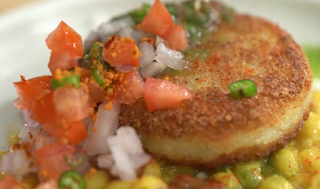Mouthwatering
‘Aloo Tikki’ is the only Indian snack that is hot, cold, sweet, spicy, salty
and tangy in every bite. A plate of tikki is full of colours as if a rainbow has stepped in the plate and for
that credit goes to khatti-meethi and mint chutneys, silky smooth curd and finally
chopped salad placed on the top of the pair. A crown of every chaat stall, a
must have snack for every north Indian wedding and north Indian parties this aloo
tikki has made its taste lovers all over India.

Preparation
and serving: Every Aloo Tikki plate has two aloo tikkies literally
translated as 'two potato cutlets' prepared from mashed potatoes added with salt to
taste, red chili powder, local spices, and a pinch of split boiled chana daal
used as stuffing placed in the middle of the cutlet, then that cutlet is deep fried on a broad
tava. These cutlets are served with khatti-meethi saunth and tamarind chutney,
coriander and mint chutney, smooth curd or chana chaat and last garnished with finally
chopped onion and seasonal salad. These can also be enjoyed only with ketchup at home.
Brief History:
There is no specific date when and where this dish was first prepared and
served. But from the story and evidence
it is pretty much evident that the current 'aloo tikki' isn’t more than 150 years
old.
Potatoes
arrival to India unfolds all the missing links. Approximately 500 years ago Portuguese introducing this crop to Indians, but the credit should be
given to Britishers for incentivizing the peasants to grow potatoes in an Indian
state named Bengal. William Fullerton (Officer and Mayor of East Indian Company
from 1772 to 1785) provided free potato seeds to the peasant in Bengal.
In 1797
campaigns were started in Bombay and Madras Provinces by Dr. Benjamin Heyne
(Scottish Missionary and Naturalist) by giving incentives and rebate in taxes
for growing potatoes.
The
Agriculture and Horticultural Society of India, in their report of the transition
in 1832 has stated the increase of potato production and peasant were also happy
growing potatoes at that time because of the frequent failure of the rice crop was a common issue during that time and during this time only Indians made potato an integral part of their diet. In the mid of 19th
century, the mentions of the potato dishes have been found in the Indian cookbooks
written in Hindi and Gujarati languages.
From the
above long discussion, it is pretty much evident that aloo tikki must have got
into existence in somewhat between 1820 till 1850 AD, but which part of India is not very clear.
Now: Aloo
tikki is considered as a popular north Indian snack, but its taste lovers could be
found in every city and village of India. Seeing its impact on the taste buds of
Indians, the international food chains entering India changed their menu to
make aloo tikki an integral part of it and 'Mc Aloo Tikki Burger' is one of the
examples. Like these chains, almost every Indian give a twist to this snack to enjoys this tikki
according to his or her taste. Aloo tikki blends very well with almost everything, it can be placed between two bread slices, can be
rolled in chapati and last can be enjoyed like this without adding anything to it with ketchup.




Comments
Post a Comment